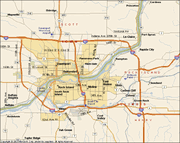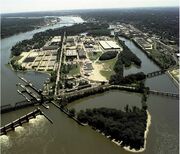![]() This alternate history related article is a stub. Please add suggestions on the talk page.
This alternate history related article is a stub. Please add suggestions on the talk page.
Working Together to Serve You | |||||||
| Capital | Davenport | ||||||
| Largest city | Davenport | ||||||
| Other cities | Moline, Rock Island, Bettendorf, East Moline, Clinton, Iowa City, Kewanee, Sterling | ||||||
| Language official |
English | ||||||
| others | Diestch, German | ||||||
| Chief Executive | Julia Norman | ||||||
| Population | est. 300,000 inh | ||||||
| Independence | June 21, 1987 | ||||||
| Currency | Barter, QCA Dollar | ||||||
The Quad Cities Alliance is a federation of survivor communites centered around the "Quad Cities", a region of the Mid-Mississippi Valley along the former U.S. states of Iowa and Illinois.
Spared from destruction on Doomsday, these communities would survive and become stabilizing force in the Upper Mississippi region.
History
Pre-Doomsday

Map of the Quad Cities Alliance
The “Quad Cities” is located along the Mississippi river approximately half way between the former capital of Iowa, Des Moines and Chicago, Illinois. The name refers to four of the five largest cities
- Davenport, Iowa
- Moline, Illinois
- East Moline, Illinois
- Rock Island, Illinois
When the city of Bettendorf, Iowa grew in size, there was talk of renaming the region the “Quint Cities”, but it never caught on.

Arsenal Island, home of the Rock Island Arsenal
Situated between Davenport and Rock Island is Arsenal Island, home of the Rock Island Arsenal. Before Doomsday, it was one of the largest weapons manufacturing facilities in the former United States. The weapons produced at the Arsenal included artillery, gun mounts, grenade launchers, and small arms. There were 250 U.S. Army personal and about 6,000 civilian employees at the site. Arsenal Island would become very important in the crises to come.
Doomsday
The first people to be alerted to the coming holocaust were the Army garrison at the Rock Island Arsenal. The commander ordered the island closed and sent the garrison to shelter. The alert of imminent nuclear attack soon reached the newsrooms of the Quad-City Times in Davenport. The staff of the Times dismissed the dispatch as a practical joke, until subsequent reports confirmed the worst.
By 8:00 PM Central Daylight Time, the entire Quad Cities region was in a state of total panic. Families did one of three things: 1) rush to their cars and try to flee the cities, 2) rush to their basements or nearest fallout shelter, or 3) realizing that options 1) and 2) would be futile if the Quads were a target, stayed at home or went to the local church.
At approximately 8:35 PM, numerous flashes appeared in the northeast, south and west of the region, followed by the appearance of mushroom clouds. It was presumed (and later confirmed) that nuclear warheads were detonated over the Iowa cities of Des Moines and Cedar Rapids, the Illinois cities of Chicago, Springfield and Peoria.
Many residents of the Quads resigned to their fate and waited for the nuclear bomb with their own names on it.
The detonation, however, would never come.
Aftermath
More to come...
Arrival of the Plains People
More to come...
Establishment of the QCA
More to come...
Liberation of Iowa City
Survivors in Iowa City, Iowa declared the Republic of Iowa shortly after Doomsday. Despite claiming all of the former state of Iowa, the state controlled only the immediate territory around Iowa City, making the survivor state a de facto city-state. Its alliance with various brigands in the 1990s soon threatened even the QCA as the western farming communities were raided. A QCA punitive expedition captured and occupied Iowa City. The new government installed by the expedition surprised the QCA by asking to join them. Though there was some support for creating a "Quintuple Cities Alliance", it was eventually decided that the current framework of the Alliance would remain.
Instead, Iowa City was reorganized into a protectorate. Iowa City would remain an autonomous territory that is protected diplomatically and militarily against third parties by the QCA. In exchange for this, Iowa City accepts specified obligations, including enforcing certain laws, provide soldiers in times of emergency, etc. However, Iowa City retains sufficient measure of sovereignty within the Alliance.
Exploration and Expansion
Following the defeat of the Republic of Iowa, the QCA began to expand their sphere-of-influence in the Tri-State Area. Dubuque became a promissing candidate for expansion since it was still relatively intact and its small population was not a threat to the QCA. In 1998, QCA soldiers occupied the town proper and declared it a "Protectorate of the Quad Cities Alliance", similar to Iowa City. The population of Dubuque began to grow again as immigration from the QCA and local farming communities rebuilt and resettled the town.
Contact with Superior
In February 2004, an outpost in Dubuque picked up radio signals from the interior of the former state of Wisconsin. In April, an expedition, led by Major Robert McAllistan, was sent to investigate the signals. The expedition reached the outskirts of the survivor community called Mineral Point where they were confronted by an armed patrol who claimed to be from the Republic of Wisconsin. After a few tense moments, the Wisconsinites were convinced of the QCA expidition's peaceful intentions.
The expediton were escorted to the capital city of Madison, which survived Doomsday. Thought parts of the city were still in ruins, there were signs of a thriving community. The expedition met with Wisconsin President Timothy Lemms and Elizabeth Rochur, an emissary from another survivor nation: the Republic of Superior, which controls most of the upper peninsula of former Michigan.
It didn't take long for Major McAllistan to figure out that Wisconsin was little more than a client state of Superior. It was through Ms. Rochur that he learned that other survivors existed in New England, Virginia, Canada, and in numerous other parts of the world. After a few days, McAllistan's group returned to Dubuque with several Wisconsin and Superior citizens, and more importantly, news of the outside world.
Boom Economy
Contact with other American survivor states revolutionized the Alliance. The economy grew at an amazing rate and towns like Dubuque transformed them into major trade hubs. By 2006, there was regular trade between QCA and Wisonsin/Superior. In 2008, a railway between Davenport and Dubuque and Madison was completed. Trade also came from Vandalia in the former American state of Illinois.
Current Situation
Territory
As of 2010, the Quad Cities Alliance controls an area of eastern Iowa and northwestern Illinois bordered by the protectorate communities of Burlington, Sterling, Dubuque, and Iowa City. There are plans to explore the area around the destroyed cities of Des Moines, Cedar Rapids, and Peoria to search for salvagable materials and evaluate the potential for future inhabitation.
Demographics
As of January 1, 2010. the population of the QCA is estimated to be about 300,000, with most of the population in the QCA proper.
Government
More to come...
Education
The QCA is served by several institutions of higher education:
- Quad Cities University (formerly Western Illinois University)
- Saint Ambrose University
- Black Hawk College
- Augustana College
Energy
More to come...
Media and Communications
More to come...
Sports
Though lacking professional leagues, the Alliance cities and their protectorates have several semi-professional leagues. Baseball, ice hockey, american football, basketball and golf all remain popular.
Foreign Relations
The QCA has formal relations with Wisconsin and Superior. Recent contact has been established with the Republic of Lincoln, the North American Union, and other survivor nations in North America. There are also rumors of survivor communities in northern part of Iowa, but these have not been verified.
| ||||||||||||||||||||||




